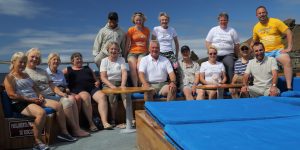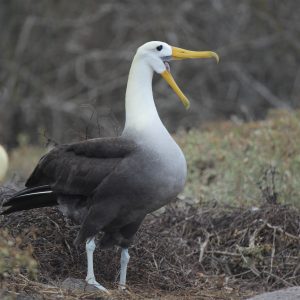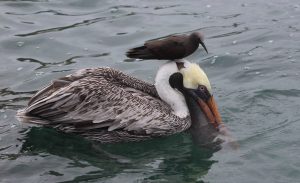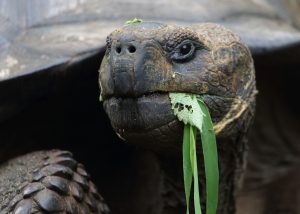
“You have reached a unique place in the world; GALAPAGOS”, proclaims a sign in the arrivals hall at Baltra airport, the ‘gateway’ to these “Enchanted Islands”, where our first birds are handsome Galapagos Doves and both Small and Medium Ground-Finches, all hopping around the café outside the airport building. From here it’s a short bus ride to the Itabaca Canal separating tiny Baltra from the much larger island of Santa Cruz, where the rocks by the jetty are adorned by bright orange Sally Lightfoot Crabs and a solitary Lava Heron, while numerous Brown Noddies, Brown Pelicans, diving Blue-footed Boobies and an occasional Galápagos Shearwater add excitement to the short ferry ride across the canal. As we drive into the central highlands of Santa Cruz, the arid landscape of xerophytic scrub is replaced by lush verdant vegetation consisting of ‘Daisy Trees’ and woods festooned with epiphytic moss, which thrives here in the moisture laden mist (La Garúa). Suddenly there are Giant Tortoises everywhere, hundreds of them, in every direction, with attendant Cattle Egrets. As the awesome dome-shelled giants trundle around, or simply wallow in muddy pools, there are plenty of Darwin’s Finches to ‘classify’, and a short stroll soon produces Small, Medium, and stocky Large Ground-Finches, with humungous bills, in contrast to the fine beak of the nearby Green Warbler-Finch. It’s remarkable to think that such starkly differing designs arose from a common ancestor! Other delights here include a black-faced male Small Tree-Finch, and a Woodpecker Finch with the jizz of a Nuthatch, as well as Galápagos Flycatchers and Mockingbirds, Yellow Warblers and Smooth-billed Anis, all at ridiculously close range, along with neat White-cheeked Pintails on a small pond, where the drakes display by erecting their tail ends behind their bowed heads, whereupon they may get ‘lucky’ with a lady.
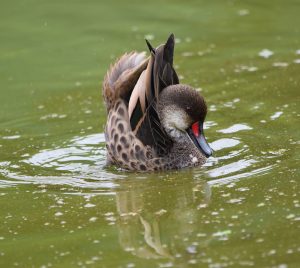
After lunch at a restaurant secluded in the forest, we visit the Charles Darwin Research Station, where tiny offspring of the Giant Tortoises are the fruits of a breeding programme to conserve the varying subspecies of tortoises which inhabit the different islands, although it was too late for Lonesome George, the last of the magnificent ‘saddlebacks’ from Pinta, who died in 2012, and is now preserved as an example of what can happen when thoughtless people interfere with nature. On the way back along the waterfront, the catch of the day, including a huge twelve foot long swordfish, is being carved up, attracting a Lava Gull, numerous Brown Pelicans, and even a Sea Lion, all waiting beside the fishermen for tit bits, like dogs at their masters’ tables. It’s dark by the time we board two inflatable Pangas, which create phosphorescent ‘sparks’ as they riffle the water en route to our yacht, the swish and sumptuous Beluga, which gently rocks us to sleep, while anchored in the channel.
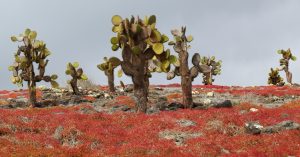
The engine starts up at 5am and by dawn we are moored in a narrow sound between North and South Plaza, ready for a dry landing on the tiny south island, where the vegetation consists of tall Prickly Pear Cactus ‘trees’ and a carpet of red succulents. Once ashore amongst snoozing Galápagos Sea Lions, with more cavorting in the shallows, a jet black male Galápagos Cactus-Finch is new for the trip, along with roosting Swallow-tailed Gulls, which are nocturnal feeders, hence the large brown eyes, bordered by a striking red eye ring. There are also tiny scurrying Lava Lizards, skinny black Marine Iguanas and hefty yellow-headed Land Iguanas, all passively vying for the attention of our cameras. One of the Land Iguanas rolls a fallen prickly pear fruit with its ‘paws’ in order to break off the fine spines, before munching on the fruit. At the far side of the island the trail follows a line of low cliffs, where thousands of Galápagos Shearwaters noisily ride the breeze, some often whizzing by at eye level just feet away from us; a spectacular experience, with Great Frigatebirds and Brown Pelicans floating by at low level, as the occasional Red-billed Tropicbird cruises by offshore. Time quickly passes with so much to see, and back at the jetty, a Lava Heron dashing forward to grab a Sally Lightfoot Crab brings a memorable morning to an exciting close.
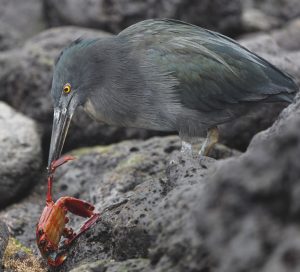
After lunch, it’s time to ‘rock ’n’ roll’ en route south to Santa Fé, where we land on a sandy beach amidst a colony of Sea Lions with suckling pups, completely unfazed by our arrival. While on the beach looking at the local doves, a Galápagos Hawk swoops in low over our heads, scattering the doves, before landing on a rock at the edge of the beach, and then posing on a small bush, oblivious to the nearby audience, busy snapping away at the hawk. Such tame behavior makes these islands a paradise for wildlife watchers and photographers. Along the trail, we literally step over large Santa Fé Land Iguanas and Sea Lions, while Galápagos Mockingbirds, Small and Medium Ground-Finches and several Yellow Warblers hop around our feet. Back at the beach, another juvenile hawk waits to be photographed, while sitting, within stroking distance, on a national park stone plaque, as if glued on by the local tourist board! A day filled with remarkable sights.
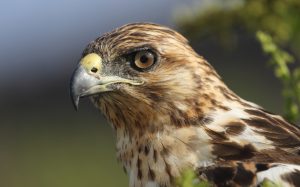
This morning we awake to the spectacular sight of Kicker Rock, a towering sheer-faced chevron of rock, looking like a giant shark’s tooth, separated from its larger neighbour by a narrow deep channel. A grey sky and a choppy swell whipped up by a stiff breeze is not an inviting mix for snorkeling, but below the waves all is calm and tranquil. Below the surface, the sheer rock face, plastered with yellow and purple soft corals and large white Volcano Barnacles, plunges vertically into a deep blue abyss, alive with a colourful variety of fish in all shapes and sizes, including diminutive Pink Cardinalfish, King Angel Fish, Galápagos Sharks and awesome Spotted Eagle Rays, while several large Green Turtles pass serenely by, and all this before breakfast! Wow!
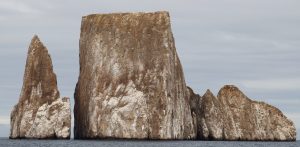
Next stop is Cerro Brujo on San Cristóbal, where shorebirds include Semi-palmated Plover, Whimbrel, Least Sandpiper, Wandering Tattler, Lava Heron, Lava Gull and even Yellow Warbler, alongside seemingly ubiquitous Sea Lions. Just inland from the beach, a lagoon produces more White-cheeked Pintails and a dozen or so dainty Wilson’s Phalaropes, with a couple of Chatham Mockingbirds in the adjacent scrub. Walking along a sweeping white sandy ‘desert island’ beach, lapped by clear blue water in the company of Sea Lions and Marine Iguanas, with the spectacular Kicker Rock on the otherwise empty horizon is a real privilege.
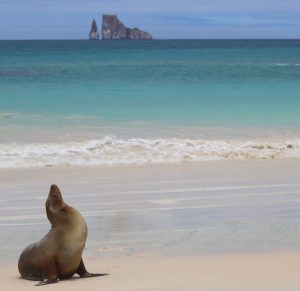
This afternoon, we have a choppy ‘wet’ crossing, for a dry landing in Puerto Baquerizo Moreno, with yet more Sea Lions and Sally Lightfoot Crabs on the waterfront. From here it is a relatively short bus ride inland and yet the climate is ‘poles apart’ with misty cloud shrouding the upland landscape, which is dripping with heavy drizzle. Consequently, the ‘viewpoint’ is not fit for purpose except for very close views of a Grey Warbler-Finch, looking remarkably like a plump Chiffchaff, but with a weak wheezy song. Ironically, back at the waterfront, the Sea Lions are still basking in the sunshine!
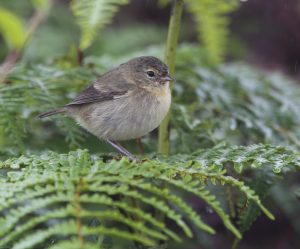
It’s a new day with a different vista; a full rainbow arcing across Gardner Bay off Española, where we land on another idyllic white sandy beach with the usual Sea Lions, as well as a welcoming party of inquisitive and vocal Hood Mockingbirds, so curious that they hop around our feet and onto our rucksacks lying on the sand! Nearby a Large Cactus-Finch hops unobtrusively on the sand near the bushes, while crushing seeds with its heavy sharp-pointed beak. Combing the beach, we also find Western Sandpiper and Marine Iguanas in bright red and green breeding colours, and then there is time to go for a swim with the Sea Lions. Back on board, it’s a quick change ready for snorkeling with playful Sea Lions and yet another Green Turtle.
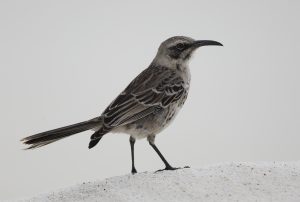
Still on Española, we land this afternoon at Punta Suarez, with good views of tiny Elliot’s Storm Petrels and Green Turtles from the dinghies on the crossing. Stepping over an ‘orgy’ of large red and black sneezing Marine Iguanas, sprawled all over each other, and all over the trail, we soon come face to face with the first of many ‘drop dead gorgeous’ Waved Albatrosses, busy performing their stylised courtship rituals, in which they ceremoniously bow, and then clap their long lemon yellow bills together, followed by taking turns to wave their heads from side to side, then standing to attention and pointing skyward, and culminating with the bizarre-looking action of holding their beaks wide open as if suddenly startled. All this is repeated and can go on for several minutes until they walk away with a slow swaggering action. What a remarkable spectacle, and surely bird of the cruise. Further along the trail, we pass through a colony of Nazca Boobies, along with one or two Blue-foots and Swallow-tailed Gulls, before reaching the blowhole, where incoming surf is compressed through a gap in the lava, forcing up roaring spouts of spray higher than a house! Next stop is the Albatross ‘runway’ where these marvelous birds take a run and jump off the edge of the cliffs, launching themselves into a flight that could take them as far as Japan! Even when airborne they continue ‘pedaling’ with their massive webbed feet, which looks quite comical. Hundreds of photos later, on the way back to the jetty, a pair of American Oystercatchers pose nicely in the early evening sun, providing even more footage for the hard-working cameras, rounding off a fantastic day on a remarkable island.
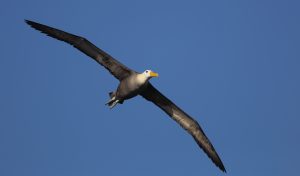
After another imperceptibly smooth overnight cruise we awake off the island of Floreana, with another rainbow over the horizon and several Elliot’s Storm Petrels defying gravity while feeding close in by the boat. First stop on Floreana is Punta Cormorant, where the large shallow lagoon is home to shockingly pink Greater Flamingoes, with several performing colourful flybys. The lovely beach at the end of the trail produces several shorebirds including Turnstone, Semipalmated Plover, Whimbrel, two Sanderlings, which are new for the trip, and a Yellow-crowned Night Heron walking towards us along the beach and then straight past us within just a few feet, while on a mission, making a bee line for a Sally Lightfoot Crab on a nearby rock! We also enjoy sightings of one or two Green Turtles offshore and lovely views of one actually on the beach! Back at the landing beach, we watch a sleeping juvenile Blue-footed Booby suddenly come to life and frantically beg for food when one of its parents arrives. After elevenses back on the Beluga, it’s a quick change ready for snorkeling at the Devil’s Crown, an aptly named jagged ring of lava formed from the weathered remnants of a partly submerged volcano. The teeming underwater life here includes chunky Chocolate Chip Sea Stars, slender-armed Blue Sea Stars, Green Turtles, purple and orange King Angel Fish, blue and yellow Razor Surgeon Fish, impressively large turquoise and pink Blue-chinned Parrotfish, and a massive shoal of shiny slender Black-striped Snappers in their thousands!

This afternoon, a leisurely Panga ride along the rocky shore, reveals four Galápagos Penguins swimming alongside the boats, more Wandering Tattlers and Blue-footed Boobies, and a pair of Magnificent Frigatebirds, perched in a low bush at the water’s edge. Landing at Post Office Bay, we pass two freshly dug Turtle nests, and sort the mail in the nearby barrel, which has been in use as a mail box since 1793, where remarkably there is a postcard addressed to Wollaton in Nottingham and dated the previous day to our visit! Floreana has a colourful human history regaled by our guide Juan, including tales of sex slavery, denture sharing and serial killings! One just couldn’t make it up.
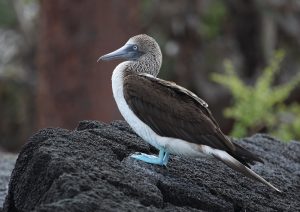
After several bumps in the night we awake near Dragon Hill off the coast of Santa Cruz, where the leafless sun-bleached trees, from a distance, look as though they are coated with a thick frost. After a dry landing on a small headland of black lava, with Blue-footed Boobies and Brown Pelicans plunge-diving into the clear blue water, we find Grey and Semipalmated Plovers, Least and Semipalmated Sandpipers and a couple of Wandering Tattlers on the small lagoon. Inland, the dry sandy soil is ideal terrain for the Land Iguanas to dig nesting burrows into, and we come across several impressively bulky yellow Land Iguanas along the walk, including a couple of posturing males which eventually work out which is ‘top dog’ after a bout of wrestling. On the rocks back at the beach, the diminutive Lava Heron has been displaced by a Great Blue. Back on the Beluga, some members of the group relax on the sun deck, while others go snorkeling with a very playful Sea Lion, eager to tug and chew the tips of people’s snorkeling fins.
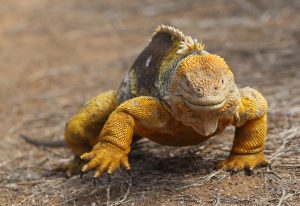
After lunch, the Beluga sets sail for Santiago, where another snorkeling opportunity awaits. As usual there are King Angel Fish and thousands of Black-striped Snappers, as well as a large but shy Hieroglyphic Hawkfish, the well named Guineafowl Puffer Fish and the spectacular psychedelic Blue-chinned Parrotfish, audibly chomping away at hard corals with its powerful jaws. The last activity of the day is a walk on an unearthly landscape of ‘fresh’ black lava, crumpled into rope-like ripples as it set little more than 120 years ago, and little changed since then. Even in this apparently sterile environment, with no soil or surface water, and baked by the tropical sun, there is life; a solitary cactus, somehow surviving in a crack in the lava, Painted Locusts, the ubiquitous Yellow Warbler, and a juvenile Lava Heron, looking very perplexed by our arrival.
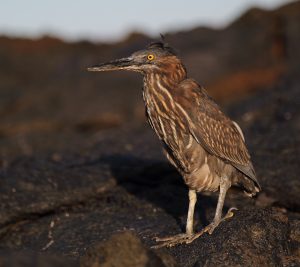
We have a turbulent overnight sailing north across the equator, with various crashes, bangs and wallops along the way, so that the dining room next morning resembles the aftermath of a saloon bar brawl, with chairs strewn across the floor! Our first landing on Genovesa is on a coral beach in Darwin Bay, amidst numerous Swallow-tailed Gulls, including a few chicks looking like overgrown juvenile Black-headed Gulls. Tiny Genovesa Ground-Finches hop around at close range, with Grey Warbler-Finch in the shrubs along the back of the beach, which are also festooned with nesting Great Frigatebirds and Nazca and Red-footed Boobies, one or two of which are white morphs. Each Frigatebird chick fills its nest, consisting of a flimsy platform of loose twigs, barely two feet above the ground. At this stage, they have the long hooked bill and dark flight feathers, with downy pale brown heads, while the mothers are close enough to show a pink eyering, and the fathers have a deep green glossy sheen on the mantle. Overhead, the air is full of Frigatebirds and Boobies, providing plenty of opportunities for flight shots at fairly close range, while time also flies by with so much action going on here.
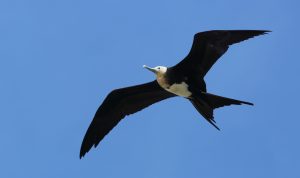
The mid morning snorkel session along the wall of the flooded caldera, which forms Darwin Bay is the best of all the swims so far, with an amazing variety of colourful fish, such as the now familiar King Angels, Razor Surgeons, Blue-chinned Parrots and Black-striped Snappers, plus powder blue Giant Damselfish, with long white-trimmed fins and tails, a Porcupine Puffer with large dark eyes and blue fins, a huge black disc-shaped Marbled Ray and beautiful black and yellow-striped Moorish Idols, with long flowing white dorsal fin streamers, delicately ‘pecking’ the rocks with their long slender snouts.
This afternoon, cruising slowly along the base of the guano-plastered cliffs, we spot Blue-footed Boobies and a couple of snoozing Galápagos Fur Seals from the Pangas, and then follow in the footsteps of Prince Philip, Duke of Edinburgh, up the cliffs and onto the flat arid surface of Genovesa, through colonies of Nazca and Red-footed Boobies, with Genovesa Ground-Finches and Large Ground-Finches along the way. Beyond the dry and dead looking shrubs is an open area of broken lava slabs, teeming with Wedge-rumped Storm Petrels, dashing to and fro like flies over a pond. The petrels nest in crevices amongst the broken lava, along with Red-billed Tropicbirds, noisily chasing each other in small groups. The plentiful prey supports a small population of Short-eared Owls and eventually we pinpoint one hunkered down in a crevice in the lava. Although it is the same species as our own Asio flammeus, this is the dark-faced galapagoensis subspecies which is perfectly camouflaged against the dark brown lava hereabouts. Before our last supper on board the Beluga, we enjoy a cocktail with the crew and thank them for a truly wonderful experience.
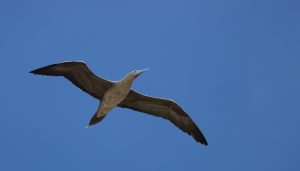
At first light, Brown Pelicans are filling their pouches with small fish hiding below the boat, as we set off for a Panga ride into the Red Mangroves of Black Turtle Cove. Paddling quietly along the tranquil backwaters, we enjoy magical sightings of numerous Green Turtles, and both Black- and White-tipped Sharks, all right alongside the dinghies. Back at the Beluga, hundreds of Blue-footed Boobies swarm around the vessel, in a feeding frenzy. It’s sadly time to say adios to the crew and disembark for the airport and a flight back to the mainland, but these fantastic islands have one last amazing experience in store; as a Brown Pelican dives into the water beside the landing stage, a Brown Noddy actually perches on the pelican’s head, hoping for an easy meal! The sign at the airport was right; the Galápagos really is “a unique place in the world”.

